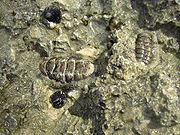
Acanthopleura granulata
Encyclopedia
Acanthopleura granulata, common name
the West Indian fuzzy chiton, is a medium-sized tropical species
of chiton
.
This species is common within its range in the tropical Western Atlantic, but it is often not noticed, because its color and texture are similar to the rocks on which it lives.
In countries that used to be part of the British West Indies, these and other common intertidal chitons are known as "curb"; the foot of the animal is eaten by people and is also used as bait for fishing.
The surface of the valves (or plates) in this species is almost always quite heavily eroded, but when not eroded, the valve surface is granulated. The valves are thick and heavy.
to Mexico
, south to Panama
, and in the West Indies.
 This species lives on rocks very high in the intertidal zone
This species lives on rocks very high in the intertidal zone
. It can tolerate a lot of sun.
Common name
A common name of a taxon or organism is a name in general use within a community; it is often contrasted with the scientific name for the same organism...
the West Indian fuzzy chiton, is a medium-sized tropical species
Species
In biology, a species is one of the basic units of biological classification and a taxonomic rank. A species is often defined as a group of organisms capable of interbreeding and producing fertile offspring. While in many cases this definition is adequate, more precise or differing measures are...
of chiton
Chiton
Chitons are small to large, primitive marine molluscs in the class Polyplacophora.There are 900 to 1,000 extant species of chitons in the class, which was formerly known as Amphineura....
.
This species is common within its range in the tropical Western Atlantic, but it is often not noticed, because its color and texture are similar to the rocks on which it lives.
In countries that used to be part of the British West Indies, these and other common intertidal chitons are known as "curb"; the foot of the animal is eaten by people and is also used as bait for fishing.
Description
This species of chiton grows to be about 7 cm (3 inches) in length. The girdle is densely spiky and usually has a few black bands.The surface of the valves (or plates) in this species is almost always quite heavily eroded, but when not eroded, the valve surface is granulated. The valves are thick and heavy.
Distribution
This chiton occurs from southern FloridaFlorida
Florida is a state in the southeastern United States, located on the nation's Atlantic and Gulf coasts. It is bordered to the west by the Gulf of Mexico, to the north by Alabama and Georgia and to the east by the Atlantic Ocean. With a population of 18,801,310 as measured by the 2010 census, it...
to Mexico
Mexico
The United Mexican States , commonly known as Mexico , is a federal constitutional republic in North America. It is bordered on the north by the United States; on the south and west by the Pacific Ocean; on the southeast by Guatemala, Belize, and the Caribbean Sea; and on the east by the Gulf of...
, south to Panama
Panama
Panama , officially the Republic of Panama , is the southernmost country of Central America. Situated on the isthmus connecting North and South America, it is bordered by Costa Rica to the northwest, Colombia to the southeast, the Caribbean Sea to the north and the Pacific Ocean to the south. The...
, and in the West Indies.
Habitat

Intertidal zone
The intertidal zone is the area that is above water at low tide and under water at high tide . This area can include many different types of habitats, with many types of animals like starfish, sea urchins, and some species of coral...
. It can tolerate a lot of sun.
External links
- Smithsonian paper by Peter W. Glynn: http://si-pddr.si.edu/dspace/bitstream/10088/5311/1/SCtZ-0066-Hi_res.pdf
- Photo of uneroded individual of this species from the Bahamas at: http://www.jaxshells.org/0430pp.htm

